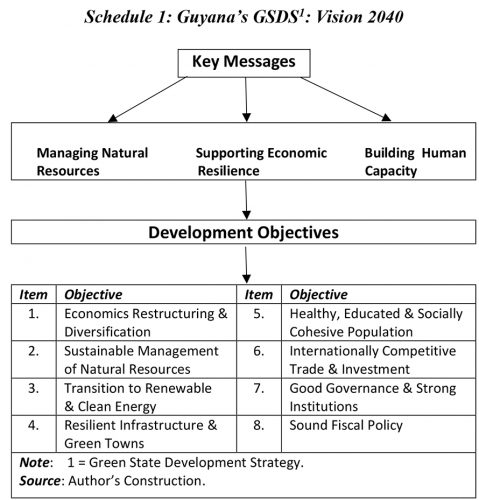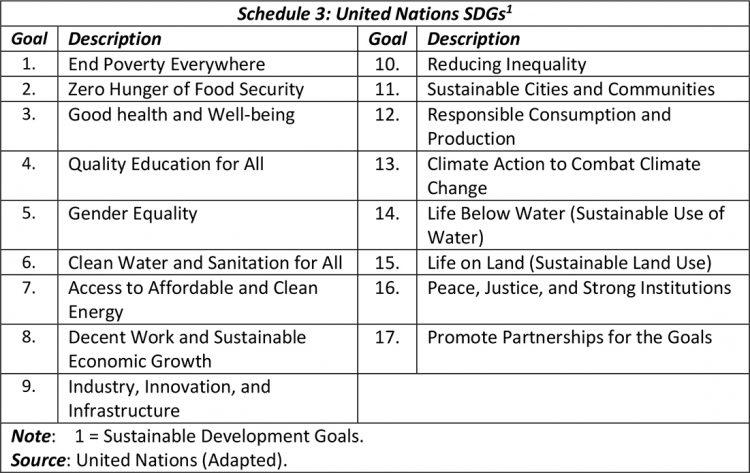Introduction
Today’s column wraps-up my discussion on spending petroleum revenues on long-term priorities
Of the Government of Guyana, (GoG), as represented in Guidepost 2 of Part 2 of the Guyana Petroleum Road Map.
In the previous column I had posited that, the GoG’s long-term priorities are indicated in two long-term strategic documents. One of these has been produced by the GoG, (the Green State Development Strategy, GGSDS); and, the other, has been produced by the United Nations, namely, the United Nations Sustainable Development Strategy (UNSDS). I had also posited in the previous column that both documents have been repeatedly acknowledged by the GoG as representing its long-term strategy for spending projected windfall petroleum revenues.
Not, unexpectedly, therefore, both of these documents overlap in their vision, analysis, and intended outcomes. The first listed document does so by choice (the GGSDS); because it followed the United Nations commitment to the SDGs in 2015. Both documents have also adopted a long-term perspective; with the GGSDS offering a Vision 2040 and the UNSDGs offering its Vision 2015 to 2030. Readers are reminded here that 2015 was the end date for the Millennium Development Goals (MDGs). Consequently, the UNSDS was conceptualized as an extension of the MDGs.
From a methodological perspective both documents did rely heavily on stakeholder consultations to authenticate them. The UNSDGs was founded on Member countries (193) active participation in the processes leading to Agreement on the 17 UNSDGs; and, as indicated last week, the GGSDS evolved out of stakeholder consultations in every Region of Guyana. Both documents faced frontally, the challenge of merging long-term development policies and environmental sustainability. In fact both sought to be inclusive and therefore go beyond the confines of traditional environmental sustainability. Further, both strategies embrace good governance, institutional transparency and accountability, as well as sound macroeconomic management.
Summary: GGSDS

Schedule 1 summarizes the GGSDS as presented last week. This has three key messages (Managing Natural Resources, Supporting Economic Resilience and Building Human Capacity). These lead directly to eight Development Objectives, namely Economic Restructuring & Diversification, Sustainable Management of Natural Resources, Transition to Renewable & Clean Energy, Resilient Infrastructure & Green Towns, Healthy, Educated and Socially Cohesive Population; Internationally Competitive Trade & Investment, Good Governance & Strong Institutions, along with Sound Fiscal Policy. Arising from these are 213 policy initiatives.
The UNSDGs
As indicated, the UNSDGs 2015-2030 build on the Millennium Development Goals, (MDGs, 2000-2015). There were eight MDGs, namely 1) End extreme poverty and hunger, 2) Universal primary education, 3) Gender equality and the empowerment of women, 4) Reducing child mortality, 5) Improve maternal health, 6) Combat HIV/AIDS, malaria, and other diseases, 7) Ensure environmental protection, and, 8) Develop a global partnership for development and implementing the MDGs. For convenience, the MDGs are summarized in Schedule 2 below.

The UNSDGs, also called the United Nations, UN 2030 Agenda for Sustainable Development, comprise 17 global goals for 169 specific areas identified by the United Nations during a “deliberation process involving 193 Member States of the UN along with global civil society (which) was agreed to by resolution on 25 September 2015.”
The 17 SDGs are 1) Ending poverty in all its forms, everywhere 2) End hunger, achieve food security and improved nutrition, and promote sustainable agriculture 3) Ensure healthy lives and promote well-being for all ages 4) Ensure inclusive and equitable quality education and promote life-long learning activities for all 5) Achieve gender equality and empower women and girls 6) Ensure availability and sustainable management of water and sanitation for all 7) Ensure access to affordable, sustainable and moderate energy for all 8) Promote sustained inclusive and sustainable economic growth, full and productive employment and decent work 9) Build resilient infrastructure, promote inclusive and sustainable industrialization and foster innovation.
10) Reduce inequality within and among countries 11) Make cities and human settlements inclusive, safe, resilient and sustainable 12) Ensure sustainable consumption and production patterns 13) Take urgent action to combat climate change and its impacts 14) Conserve and sustainably use oceans, seas and marine resources for sustainable development 15) Protect, report and promote sustainable use of terrestrial ecosystems, sustainably manage forests, combat desertification and halt and reverse land degradation and biodiversity loss 16) Promote peaceful and inclusive societies for sustainable development, provide access to justice for all, and build effective, accountable and inclusive societies at all levels; and finally 17) Strengthen the means of implementation and revitalizing the global partnership for sustainable development. For convenience, these 17 SDGs are summarized in Schedule 3.

Conclusion
Next week I address the GoG’s medium-term priorities and also wrap-up the discussion of Guidepost 2 in my presentation of Guyana’s Petroleum Road Map, Part 2.










